Caerphilly Cheese – Like Cheddar But Quicker
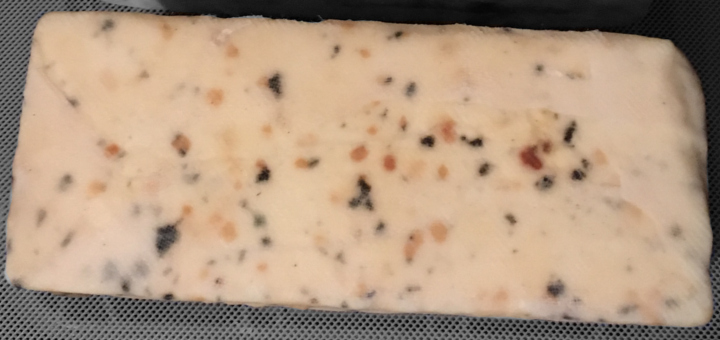
Traditional Welsh Caerphilly cheese is documented as being first produced in 1830 in the town from which it takes its name. The process of production resembles that of making cheddar, which results in similar flavor and texture. However, Caerphilly will have a notably crumbly texture.
Generally, I have the cheese cultures and forms to make cheddar. However, on the day that I had access to fresh milk, I did not have time. A make day for Cheddar lasts a minimum of eight hours; Caerphilly is easily done in under five hours. The main reason for the reduction in time is that one does not need to cheddar the curd. Also, salting is done after pressing which also speeds up the processing.
Typically one would expect a Caerphilly to be pressed in a round form; please forgive my brick-shaped version. I did also bandage-wrap this cheese as the humidity needs of a healthy natural rind are beyond my current abilities. A natural rind is possible with relative humidity around 85 percent; for a Caerphilly wheel, one should be shooting for 95 percent relative humidity.
| Amount | Contents |
|---|---|
| 16 L | Local, raw milk |
| 2/3 tsp | Omega cultures (mostly meso) |
| 3 Tbsp* | Calf Rennet |
| 1-2% Curd Weight | Salt -> Dry Rub |
| Phase | Target Range | Actual |
|---|---|---|
| Begin | 6.6-6.7 | 6.60 |
| Rennet | 6.4-6.6 | 6.39 |
| Drain | 5.9-6.4 | 6.31 |
| Hooped | 5.3-5.5 | ? |
*Note that the calf rennet I have is diluted to 1:1000. Normal strength rennet is diluted to 1:12000. This means that I am using 12 times the amount that is typical shown in recipes; in this case, 1/2 tsp of typical-diluted rennet is called for for ten liters of milk.
^It may be worth noting that those moving on to hooping the curd and forming a wheel (or block), the pH target for filling the cheese mold and pressing is 5.2.
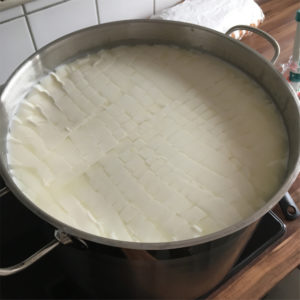 This cheese make day occurred in late October 2017. I had purchased the normal 20 liters of milk, and I separated 4 liters for making Quark (a.k.a. fromage blanc). The latter did not turn out, so you will not find it mentioned until I get it right.
This cheese make day occurred in late October 2017. I had purchased the normal 20 liters of milk, and I separated 4 liters for making Quark (a.k.a. fromage blanc). The latter did not turn out, so you will not find it mentioned until I get it right.
With my baker internship starting at 1 AM on Monday mornings, the Sunday required a quickly completed cheese option. I had made Caerphilly a couple times before in San Francisco. One may buy additional cultures to ensure better rind and flavor development; however, I am always satisfied with local flora and the unique qualities that they bring.
Again, my calibration liquids do not match my calibration settings on my pH meter. I adjust for this discrepancy by subtracting 0.14 from the meter reading; it is not absolutely accurate, but close enough for this purpose.
| Time | Activity |
|---|---|
| 12:10 | Milk in pot (milk was stored in cool basement overnight) |
| 12:25 | 68°F |
| 12:35 | 74°F |
| 12:46 | 83°F |
| 12:54 | 6.74 – 0.14 = 6.60 pH |
| 12:55 | 89°F (Goal Temperature for Cultures) |
| 12:58 | Add Cultures |
| 13:04 | Stir well – approximately one hour hold |
| 13:10 | 91°F |
| 14:03 | 90°F; 6.53 – 0.14 = 6.39 pH |
| 14:04 | Add rennet |
| 14:15 | Flocculation point achieved; multiple is 2.5; cut curd at 14:32 |
| 14:32 | Cut curd into 3/4 inch cubes |
| 14:37 | Cut complete; let heal |
| 14:40 | Stirring gently |
| 14:48 | With curds in motion, starting to gently heat and stir |
| 15:02 | 90°F |
| 15:12 | 94°F |
| 15:13 | 6.45 – 0.14 = 6.31 pH |
| 15:18 | 96°F – goal temperature; turned off heat; hour rest |
| 16:18 | Poured off whey (forgot to measure pH) |
| 16:32 | Curd in form; pressing at 20 lbs |
| 16:45 | Flipped the cheese; pressing at 30 lbs |
| 05:30 (+1) | Cheese from mold; dry salted (~50g salt) -> Done in two rounds / 10 minute rest |
As one may notice, once the milk is at temperature, the make process for Caerphilly takes only four hours. With an hour wait for the cultures to do their thing and another hour of pitching the curd, this is a very hands-off cheese; this is very much unlike its high-maintenance, needy cousin, the Cheddar.
While I do like the Caerphilly taste, this cheese is not known for being served in slices. The paste, which is the inner part of the cheese (everything that is not the rind), will stick to a knife and will crumble while cut. As such, it is best suited for being melted or shredded in dishes. This four pound brick of cheese is slowly being incorporated into my morning egg sandwiches. It has also found its way into my made-from-scratch grilled cheeses.
An interesting note is that I lack the desire to build and maintain a brine. My reasoning is that my apartment is rather small and I am hesitant to buy too many ‘things’ while living abroad. As such, the Cheddar is a cheese whose curds are salted prior to being pressed; no brine needed. Without a brine for the Caerphilly, I had resorted to dry salting the pressed cheese.
Dry salting is a rather quick process when compared to brining. In a brine, the salt content of the surrounding water attempts to equalize with the salt content of the submerged cheese. This means that the salt flows into the cheese over a period of 12 or more hours. With dry salting, the cheesemaker smothers the outside of the wheel with salt, lets that salt be pulled into the wheel for an hour or so, then flips and repeats. Cheese literature suggests salt application from between one and two percent of the wheel’s weight in salt.
This Caerphilly was aged for five months in my cool, humid basement. The rind developed a good amount of color. The finish product had a fantastic, sharp taste. Again, the crumb is annoying and messy, but the cheese transitions from milk-in-a-pot to wheel in record speed. Enjoy!
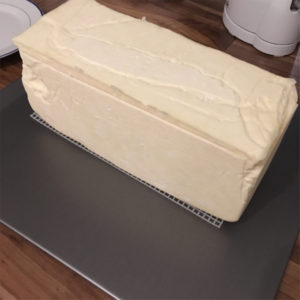
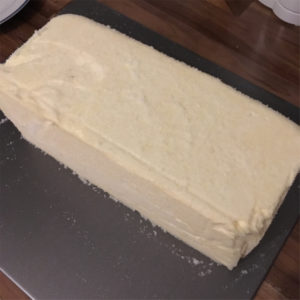
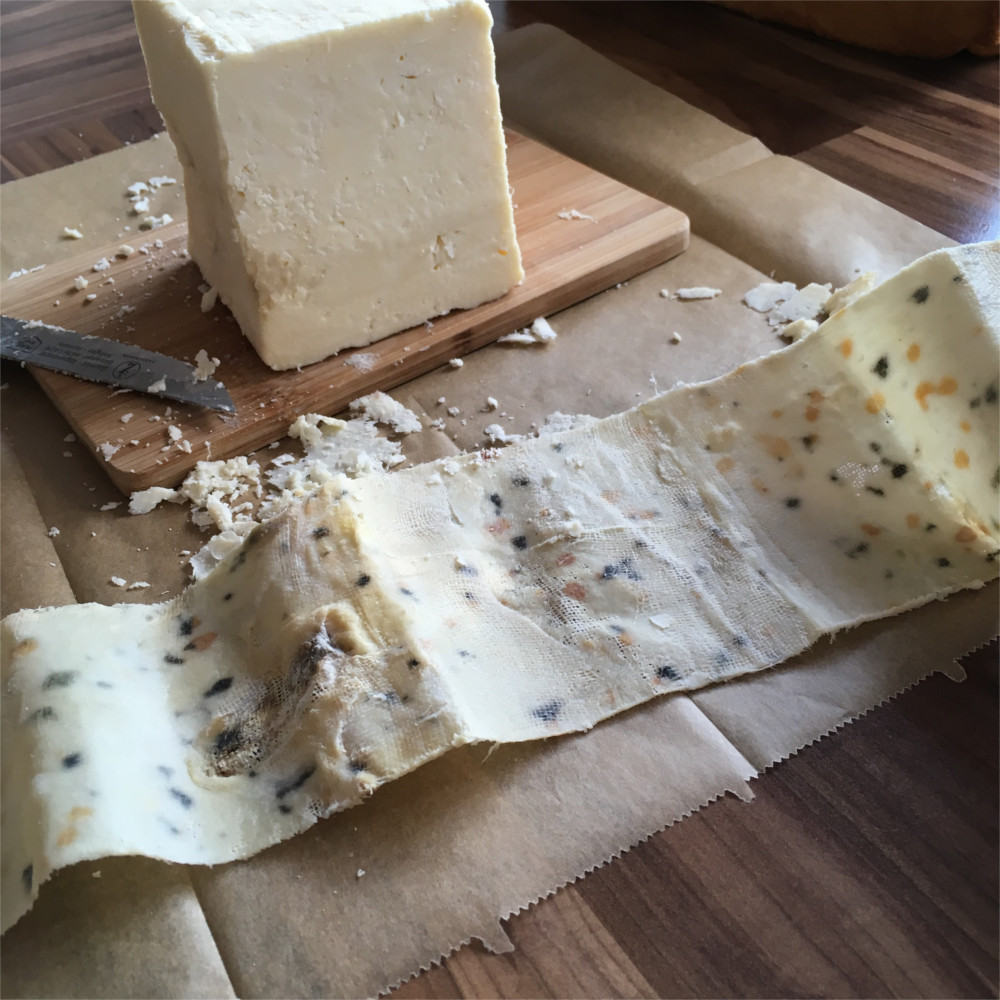
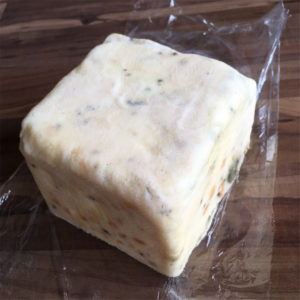
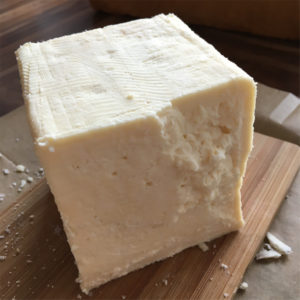


I’d like to taste that too, even more than your hummus (which I already know).
🙂
Thanks for the great manual
Thanks, it is quite informative
This is truly useful, thanks.